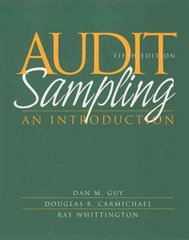Question
Issues What would you recommend to top management regarding the three problems they have identified? Are there any matters not mentioned by the top management
Issues
- What would you recommend to top management regarding the three problems they have identified?
- Are there any matters not mentioned by the top management that you feel are problematical?
Facts
Tru-Fit Parts, Inc, manufactured parts of use automobiles, trucks, buses, and farm equipment. The parts constituted three major groups: ignition parts, transmission parts, and engine parts. The company's parts were sold to original-equipment manufacturers (OEM market) and to wholesalers who were the main link for the distribution of replacement parts (The "aftermarket" AM).
Exhibit 1 showed Tru-Fit's manufacturing division for its three product groupings. Each division was treated as an investment center and was responsible for manufacturing parts, and selling its parts to the OEM market. Each division sold parts to the fourth division, AM Marketing. This division was responsible for Marketing Tru-Fit parts to AM Wholesalers.
Before intracompany sales were eliminated, the sum of the four divisions was about $1 billion a year. Distributed as follow: $260 million was attributed to the Ignition Parts Division, $200 million to Transmission Parts Division, $180 million to the Engine Part Division, and $360 million to AM Marketing. After the intracompany sales were eliminated sales totaled $800 million. Intracompany sales constituted almost a third of the manufacturing division's volume. The management's goal was to increase to 50 percent The AM portion of outside sales from the current level of 45 percent.
Within each manufacturing division, each plant was treated as an investment center. OEM sales were credited to the plants. A plant's ROI target was based on budgeted profit. The actual ROI was profit divided by the actual beginning of year assets. Beginning of year net assets was used because added investment in a given year might result in little if any, profit in that year, but rather would increase later year's profits. Management felt that such investments might not be proposed if investment center managers were penalized. OEM and AM marketing, management did not want to consolidate AM and OEM activities in a single organization.
The factors critical to success in the OEM market were (1) the ability to design innovative dependable that met customer's performance (2) meeting OEM delivering requirements so that the OEM company could minimize its own inventories and (3) controlling costs. In the AM market availability was the most important factor followed by quality and price.
Approximately 50 Tru-Fit line managers and staff participated in an incentive bonus plan, which worked as follows. First, the size of the bonus was established; its size was related by a formula of corporate earning per share. Each participant had a number of "standard bonus points" the higher the participant was in the organizational hierarchy, the more standard points the participant had. The total of points was divided into the bonus pool to reach a standard dollar award per point. The standard dollar award was multiplied by the participant's number of standard points to arrive at the participant's "standard bonus." The award varied upward and downward as much as 25 percent.
In the case of the plant manager, the standard award was related to a formula that related the standard award to the plant's profit variance. The plant's profit was adjusted for any favorable or unfavorable gross margin variance caused by sales volume to the AM Marketing division. The plant manager's bonus would not be raised above 100 percent of the standard. Top management was satisfied with the current performance design, however, they mentioned three areas of concern.
First, there were always dispute over the transfer prices from the manufacturing division to AM Marketing. Problems occurred when the part being transferred was strictly an AM part-one that had never been sold by the OEM market. The transfer price issues were resolved by the two divisions, but sometimes the corporate controller arbitrated a dispute.
Second, management felt that when AM Marketing and an outside OEM customer were placing competing demands on a plant, the plant usually favored OEM customers. Management was not willing to let AM Marketing sell a competitor's product.
Third, management felt that AM Marketing and the three manufacturing divisions carried excessive inventories most of the year.
Step by Step Solution
There are 3 Steps involved in it
Step: 1

Get Instant Access to Expert-Tailored Solutions
See step-by-step solutions with expert insights and AI powered tools for academic success
Step: 2

Step: 3

Ace Your Homework with AI
Get the answers you need in no time with our AI-driven, step-by-step assistance
Get Started


